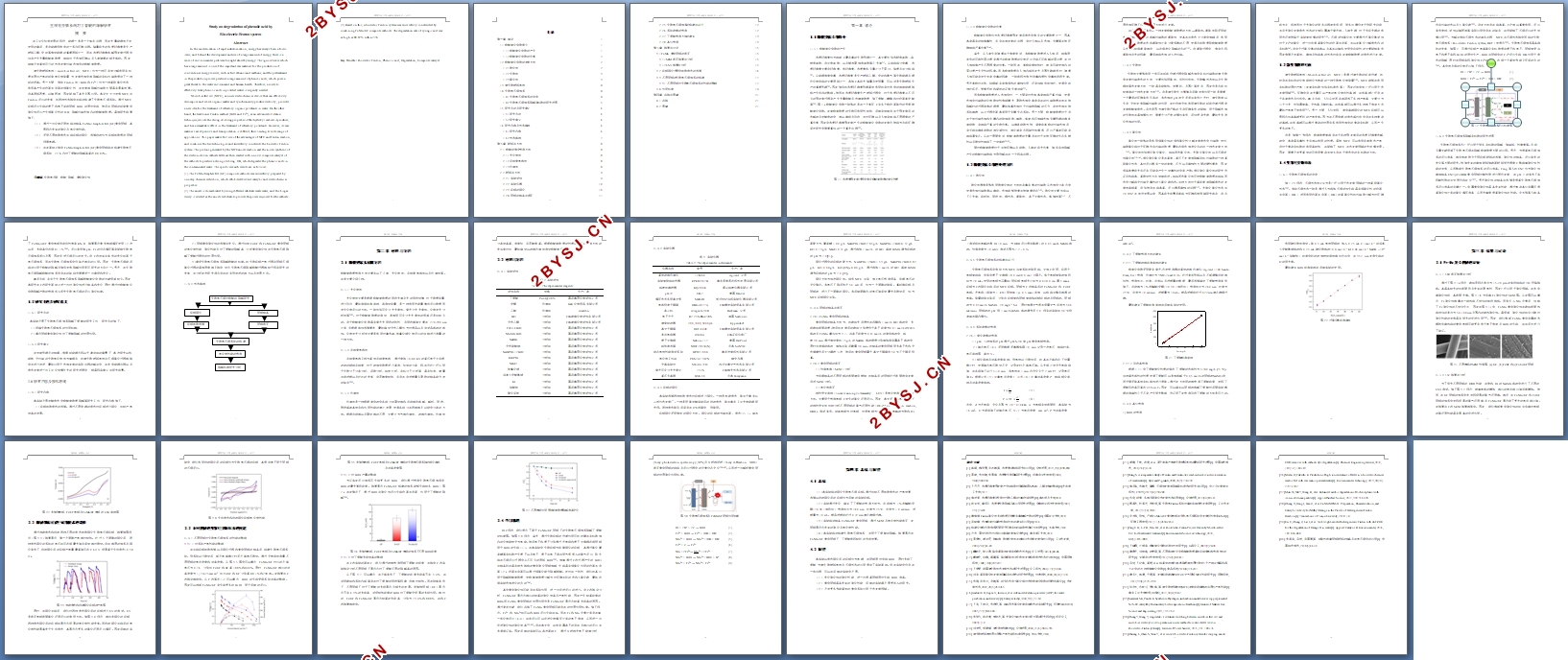生物电芬顿系统对丁香酸的降解研究
无需注册登录,支付后按照提示操作即可获取该资料.
生物电芬顿系统对丁香酸的降解研究(任务书,开题报告,外文翻译,论文11700字)
摘 要
在工业化快速发展的现代,能源一直是一个焦点问题,而在大量能源被开发使用的背后,是由能源所带来的一系列环境问题。储量巨大的木质纤维素是生产燃料乙醇、甲烷等常规能源的重要原料之一,而在木质纤维素热解预处理过程中则会产生大量酚酸类物质,造成对于水体环境以及人类健康的极大威胁。因此,继续开发高效可行的技术处理污染水体中的酚酸类物质。
微生物燃料电池(microbial fuel cell,MFC)作为一种可有效分解利用有机质并同步产电的新型电化学装置,为处理水体中难降解的有机污染物提供了一种新的思路。另一方面,传统Fenton法(H2O2和Fe2+)作为一种高级氧化技术,利用其产生的羟基自由基的强氧化性,在处理难降解污染物方面具有显著效果。但其原料昂贵、运输困难,因此限制了其大范围应用。本论文充分发挥MFC与Fenton反应的优势,将两种技术结合并成功构建了生物电芬顿系统。通过MFC 阳极反应生成的质子和电子驱动阴极H2O2 的原位合成,然后与阴极的新型复合催化剂反应产生强氧化性的•OH,降解污染水体内的酚酸类物质。具体研究成果如下:
通过一步化学还原法成功制备Fe-Mn/ Graphite felt (GF)复合阴极,其展现出优良的催化及电化学性能。
采用不同底物废水完成阳极的驯化,选择沼液作为阳极底物提供阴极所需电源。
在此基础上结合Fe-Mn/Graphite felt (GF)复合阴极成功构建生物电芬顿系统,22 h内对丁香酸的降解率高达88.82%。
关键词 :生物电芬顿 酚酸 降解 复合催化剂
Study on degradation of phenolic acid by
Bio-electric-Fenton system
Abstract
In the modernization of rapid industrialization, energy has always been a focus issue, and behind the development and use of a large amount of energy, there is a series of environmental problems brought about by energy. The lignocellulose which has a large amount is one of the important raw materials for the production of conventional energy sources, such as fuel ethanol and methane, and the pretreatment in the production process produces a large amount of phenolic acids, which poses a great threat to the water environment and human health. Therefore, a route to effectively treat phenolic acids in polluted waters is urgently needed.
Microbial fuel cell (MFC), as a new electrochemical device that can effectively decompose and utilize organic matter and synchronously produce electricity, provides a new idea for the treatment of refractory organic pollutants in water. On the other hand, the traditional Fenton method (H2O2 and Fe2+), as an advanced oxidation technique, utilizes the strong oxidizing properties of the hydroxyl radicals it produces, and has a remarkable effect in the treatment of refractory pollutants. However, its raw materials are expensive and transportation is difficult, thus limiting its wide range of applications. This paper makes full use of the advantages of MFC and Fenton reaction, and combines the two technologies and successfully constructs the bioelectric Fenton system. The protons generated by the MFC anode reaction and the in-situ synthesis of the electron-driven cathode H2O2 are then reacted with a novel composite catalyst of the cathode to produce a strong oxidizing •OH, which degrades the phenolic acids in the contaminated water. The specific research results are as follows:
(1) The Fe-Mn/Graphite felt (GF) composite cathode was successfully prepared by one-step chemical reduction, which exhibited excellent catalytic and electrochemical properties.
(2) The anode is domesticated by using different substrate wastewater, and the biogas slurry is selected as the anode substrate to provide the power required for the cathode.
(3) Based on this, a bioelectric Fenton system was successfully constructed by combining Fe-Mn/GF composite cathode. The degradation rate of syringic acid was as high as 88.82% within 22 h.
Key Words : Bioelectric Fenton; Phenolic acid; Degradation; Composite catalyst


目录
第一章 绪论 1
1.1酚酸类化合物简介 1
1.1.1酚酸类化合物的产生 1
1.1.2酚酸类化合物的危害 2
1.2酚酸类化合物的处理方法 2
1.2.1物化法 2
1.2.2生物法 3
1.2.3氧化法 3
1.3微生物燃料电池 4
1.4生物电芬顿体系 4
1.4.1生物电芬顿体系的由来 4
1.4.2生物电芬顿体系降解有机物的研究进展 5
1.5研究目的及研究意义 6
1.5.1研究目的 6
1.5.2研究意义 6
1.6研究内容及技术路线 6
1.6.1研究内容 6
1.6.2技术路线 7
第二章 材料与方法 8
2.1 酚酸的常见检测方法 8
2.1.1光化学法 8
2.1.2毛细管电泳法 8
2.1.3色谱法 8
2.2 材料与方法 9
2.2.1 实验试剂 9
2.2.2 实验仪器 10
2.2.3 阳极的驯化 10
2.2.4 阴极的制备与表征 11
2.2.5 生物电芬顿体系的构建与运行 12
2.2.6 系统参数的检测 12
2.2.7 丁香酸检测方法的建立 13
2.2.8 其它检测 13
第三章 结果与讨论 15
3.1 Fe-Mn 复合阴极的表征 15
3.1.1 SEM表征结果与分析 15
3.1.2 LSV结果与分析 15
3.2 阳极驯化过程中底物废水的选择 16
3.3 不同阴极的生物电芬顿体系的构建 17
3.3.1 不同阴极对生物电芬顿体系的性能的影响 17
3.4 作用机理 19
第四章 总结与展望 21
4.1 总结 21
4.2 展望 21
